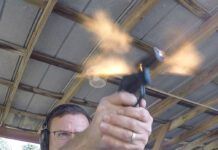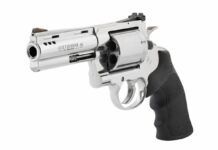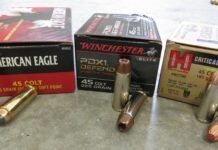If you have never actually fired a revolver chambered for .44 Magnum, your reluctance is likely based upon their reputation for infamous levels of recoil. You may like the idea of shooting what Harry Callahan dubbed the world’s most powerful handgun—which it was at one time—but muzzle energies of 900 foot-pounds or more that equate to power factors above 300 can be too much to deal with regularly.
But GT decided to brave the blast and test three 6-inch (or thereabouts) models; Taurus’ Model 44, $530; the $630 Smith & Wesson 629 Classic, and Ruger’s $515 Redhawk. The Ruger had a 5.5-inch tube, and the Smith’s and Taurus barrels were 6.5 inches long. Our mission, as always, was to collect objective performance data at the range, and using those numbers, form opinions about whether to buy, or not buy, any of these guns. And, as always, we are completely partisan about making those judgments: We like accurate, reliable, comfortable-to-shoot firearms. All others need not apply.
Range Session
We collected our accuracy range data at 25 yards, shooting a Federal American Eagle .44 Magnum 240-grain jacketed hollow-point bullet, a Winchester .44 Magnum 240-grain jacketed soft point bullet, and a PMC 180-grain jacketed hollow-point bullet in .44 Special. Also, we shot the guns at handgun silhouettes and ran them double action in a rapid-fire test. The drill was to fire five five-shot volleys into a single target as fast as the desired sight picture could be acquired. We then reported how many shots were in the black and calculated what percentage of shots were well aimed. All told, each gun was fired a minimum of 150 rounds of .44 Magnum and 50 rounds of .44 Special.
The full-power magnum loads were tiring and required the use of a heavily padded Past glove. However, the .44 Special ammo in these big guns proved to shoot as pleasantly as a .38 Special target load.
All three guns arrived with a ramped front sight with orange inserts, which we feel is a detriment to accurate shooting. Whether your eye responds to the orange insert or not, its slick surface reflects too much light to offer clear definition. Perhaps some day one company or another will think to cut glare-eating lines into the soft plastic insert.
During testing, we noticed that the .44 Magnums require a more enthusiastic chamber-cleaning regimen than revolvers in other calibers. Each of the guns suffered from cylinder bind during the rapid-fire test because the empty shells interfered with the necessary headspace. Reason: During recoil, the gun moves upward and backward; correspondingly, the shells in the cylinder shift forward toward the breechface. If the chambers get too dirty, the empties aren’t able to slide back into the cylinder after recoil, thus causing binding. When this problem occurred, we simply cleaned and lubricated the chambers.
Taurus Model 44
Our recommendation: While not a true target model, the $530 Taurus 44 adds the right amount of weight and enough compensation to produce a versatile weapon. It’s fun to shoot at the range, and it’s capable of awesome stopping power.
The Model 44 arrived highly polished and included the Taurus factory-installed porting system. This system adds 0.5 inch to the length of the barrel and consists of an expansion chamber bled by 8 round ports, four on each side of the front sight. How much does this system reduce recoil? It is very hard to quantify this scientifically, but the .44 Special loads were appreciably softer fired from this gun than the two others in this test. However, because the M44 is also the heaviest gun in the test with the most massive underlug, its mass alone likely helped dampen our perception of recoil.
We rated the rubber grip on this gun to be very good as well. Each of the guns in the test has a different backstrap, grip design, and center of gravity. What we liked about the Taurus grip was its rubber did a good job of insulating the hand from shock but didn’t trap the hand with overly aggressive finger grooves. Its surface was not slippery nor was it too tacky. Overall, we thought the Taurus M44 recoiled the least.
Each of the three guns sported DA trigger pulls of more than 12 pounds, the Taurus being the heaviest right at 13 pounds. But we thought it was easier to pull than the Ruger and was just as smooth as the S&W gun. Taurus uses a coil spring instead of torsion-bar mainspring. Two clicks are faintly evident before firing but there is little hint of stacking. This malady, typically found in coil spring guns, is minimized in the Taurus because the spring is so much longer the stress can be more evenly distributed.
This paid dividends during the rapid-fire test. Only three of 25 shots fired standing unsupported at 10 yards landed out of the black (88 percent). However, the shots that were off, were way off. Why? Because the action momentarily bound and then suddenly let go, destroying accuracy. Investigating this problem we found that the cylinder would spin freely empty or fully loaded with unfired rounds. But we found that the cylinder was impeded once there were three or more empty shells in the cylinder. During the bench rest session we had noticed it was difficult to eject spent shells without having to pull them out by hand. One cause for this to happen could be that the chambers were unnaturally large or out of spec. Expansion of the shell casings is expected, and the elasticity of the brass is even depended upon to absorb a small amount of energy. But, allow the brass to expand too much and it will not be able to snap back into spec. Then you are left with the case wall plastered against the inside of the chamber. To make sure this was not the case we sent the Taurus (as well as the Redhawk and the 629 Classic) to John Barr at Barr Performance Products, (713) 462-0740, to measure and profile the chambers.
All three guns proved to be in spec. The Smith & Wesson was the tightest, with straight-walled chambers measuring 0.458 inch leading to a bullet bore of 0.428 inch. The Redhawk was loosest, with a tapered chamber shrinking from 0.462 inch to 0.459 inch and a variation in bullet bore from 0.4305 inch to 0.431 inch. The Taurus actually showed the second tightest set of chambers, tapering from 0.460 inch to 0.457 inch with a consistent bullet bore of 0.429 inch.
With this information in hand we went looking for another reason why the empty shells were reluctant to shift smoothly back into the chambers. Visually inspecting the chamber of the Taurus revealed that they are finished with a set of fine striations perpendicular to the bore. This makes the chamber walls of the M44 more susceptible to fouling, we believe. After cleaning the chamber, we made it a point to test for over-expansion with hot magnum loads and for fouling with .44 Special “Cowboy” loads that featured a soft lead bullet. This confirmed that the reliability problems were likely due to fouling, and we made sure to keep each chamber cleaned and lubricated. As a long-term solution, we would have the chambers polished.
As we noted before, the front sight included a plastic insert, which we didn’t like. The Taurus’s sight picture offered the widest light bars matching a rear notch of 0.127 inch to a front blade of 0.12 inch over the longest sight radius of 8.6 inches. Although pinned in place, the front blade did become loose, but didn’t leave its post. At the silhouette range, we had to hunt for the proper hold on the turkeys at 75 yards and the rams at 100, and we never felt confident shooting the Taurus at those distances. Without better-quality sights, we think 50 yards is the realistic boundary of this revolver’s dependable accuracy.
Smith & Wesson 629 Classic
Our recommendation: Buy it. We can’t fault a $630 revolver that shoots small groups of hot ammunition out of the box. However, its recoil is stout and its sights need work.
When we measure five-shot groups from benchrest sessions, we publish the longest distance measured center to center from the widest two of the five shots. We also take note of any cluster of hits within the overall groups and mention them if we feel they’re relevant. In the case of our session with the 629 Classic, we should point out that we’re not perfect, and our test shooters do pull a shot or two. How else would you explain five shots of the Winchester round measuring 0.80 inch when four of those shots spanned only 0.40 inch? Likewise, the smallest Federal group measured 1.5 inches, but we had three shots within 0.40 inch as well. With the PMC .44 Special ammo, the average doesn’t look like much, but three shots in a single group measured a mere 0.16 inch.
Perhaps a good deal of the credit for the 629’s showing at the bench should go to its single-action trigger. In this case we feel the weight of the single-action movement (4.5 pounds) is irrelevant. It was so smooth that we fired the 629 prematurely on several occasions. The double-action trigger on this gun cannot be faulted either. In the rapid-fire drill, only one shot of 25 strayed from the bull (96 percent).
Shortcomings in the handling and performance of the Smith & Wesson 629 Classic pale in the light of its accuracy, but we also experienced a momentary bind when we fired the gun double action. The test shooter reports that the high recoil may have been contributing to a tendency to short-stroke the trigger, not letting it move completely forward between shots. Cleaning the chambers also seemed to help.
A stubborn cylinder latch made swinging the cylinder away from the frame difficult. We found that when pressing the latch forward we were being fooled into thinking it was all the way in. We discovered that it needed an extra push to disengage.
The Hogue rubber monogrip would not be our choice for handling the .44’s recoil. Though the open backstrap design leaves zero gap between the hand and the grip—a desirable trait—the 629’s grip otherwise captures the hand with a sticky rubber compound and deep finger grooves. There’s no place for the gun to go, so the hand, wrist, and arm absorb all the recoil. After letting off six rounds of the Winchester 240-grain jacketed soft points, we expected to see a detached arm lying on the ground with the gun still rooted firmly in the hand. Hogue’s wooden grip or even Smith & Wesson’s older style two-piece grip might be a better choice.
Ruger Redhawk
Our recommendation: Listed at $515 MSRP, the Redhawk is not only the least expensive gun in this test, but we surmise it to be the strongest of the three. Its stainless-steel fabrication makes it appear to be carved out of a single chunk of steel.
All three test guns surpassed the accuracy displayed by most of today’s revolvers and semi-autos that are sold as target models. The Redhawk may have posted a third best average for the Federal ammunition, but when you factor in the human error possible during a hand-held test, you have to say that 2.0 inch versus 1.9 inch is a tie.
The Redhawk trailed somewhat with the .44 Special cartridges, and we think this capsule rundown tells the story of the Redhawk. This is a .44 Magnum from the ground up. Even the cylinder stop stands twice as high through the frame into the timing groove as on its competitors. The front sight is firmly dovetailed via a base that is more than 50 percent of its total mass, and it sits up high enough to offer a commanding sight picture. Despite a single action that we feel is unnecessarily heavy and a trigger that needs to be radiused for comfort, it was the only gun we tested that was successful at knocking down turkeys and rams as well as the pigs without any sight adjustment. Sporting the shortest sight radius of “only” 7 inches, we could accurately confirm an index and properly adjust our hold to compensate for increased distance.
Firing double action at our rapid-fire distance of 10 yards left only two shots outside of the bull (92 percent), but the shots were spread out over the target. We attribute this to a heavy DA trigger that locks momentarily into a staged position just before let-off. This is different from, but feels the same, as a stacking trigger. We also noted some binding during the rapid fire segment. We feel that debris discouraged the spent shells from re-entering their chambers after recoil.
This malfunction was minimized by keeping the cylinders clean.
In terms of the gun’s feel, we noted the edge of the trigger’s face is squared off and uncomfortable to use. The wooden grip is rounded like a cowboy single-action gun, and the shape allows the gun to ride up and return to the natural grip, partially dissipating recoil. We’d like to see the grip fill more of the area between the front strap and the rear of the trigger guard. This would make the position of the weak hand more comfortable underneath the trigger guard.
All three guns have sight enhancements that are generally recognized as devices to speed sight acquisition. In each case the inclusion of an orange insert and a white outline on the rear blade detracts from the type of fine sight picture necessary for accurate long distance shooting. Certainly there are better choices of front/rear sight combinations for a silhouette gun, but we feel Ruger has reached a best possible compromise between a target sight and a combat sight.
Gun Tests Recommends
Taurus Model 44, $530. Conditional buy. Although slightly more expensive here than the Ruger, Taurus revolvers can often be found selling for less than their competitors, and this model offers enough power to be a very good home defense weapon as formidable as any firearm short of a 12 gauge shotgun. While not quite a competition grade gun, it is has every other advantage the .44 Magnum caliber can offer. That is, enough ballistic versatility for pleasant target shooting and the capacity to deliver a decisive blow with a slightly higher level of comfort than the uncompensated models. If Taurus fixed the sights on this one, we would move it into the unqualified “Buy” category.
Ruger Redhawk, $515. Buy it. We were surprised by the low MSRP. The construction and workmanship were excellent. The sights allow you to take rapid aim for defense and plink out to 100 yards. It could stand a little trigger work and the rounding of some edges, but this could be your best all-round Y2K weapon. If the world doesn’t end and you don’t need it for subsistence hunting or home defense, you can always use it to enjoy a good, civilized Bullseye or Steel Silhouette match.
Smith & Wesson 629 Classic, $630. Buy it. Other than a change of grip and possible front-sight blade change, we can’t fault a revolver that shoots small groups of volcanic ammunition out of the box. Any gap in price between the Redhawk and the 629 Classic would certainly be narrowed after the Ruger was charged with refinements.























